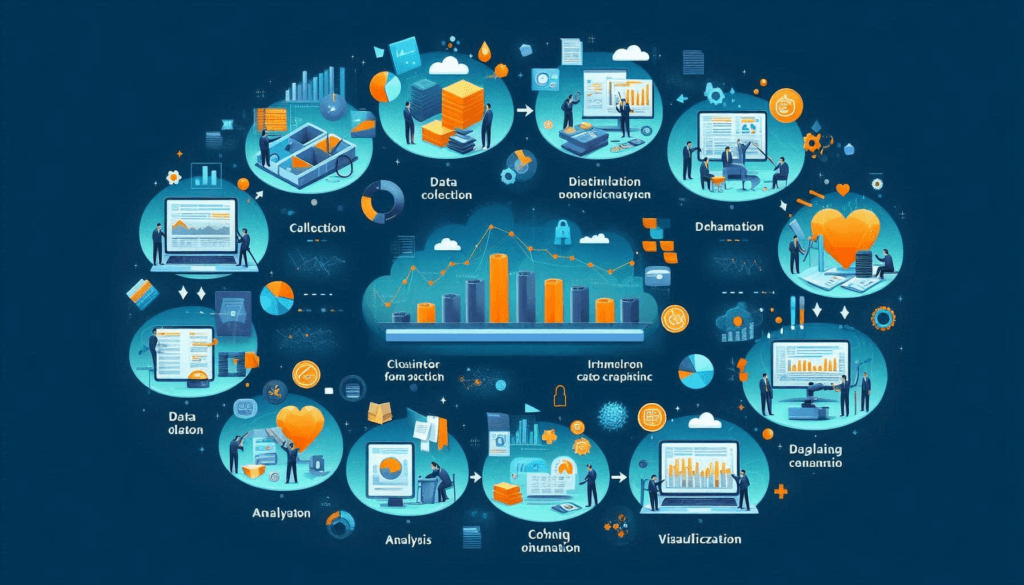Welcome to a portal where bytes of innovation converge, ushering in a new Technology Moment. Here, we explore the frontier of digital evolution, from groundbreaking advancements to the latest trends shaping our interconnected world. Join us as we delve into the transformative power of technology, illuminating the path ahead in this era of rapid change and limitless possibilities. Welcome to your gateway to the future on portal.php.
Overview of Web Portals and Their Significance
In the introduction, we begin by defining what web portals are. Web portals are websites that serve as a gateway or entry point to a variety of information, resources, and services. They are designed to provide users with a unified access point to content from various sources, often personalized to meet specific user needs. Examples of web portals include news aggregators, corporate intranets, and educational platforms.
What is portal.php?
Next, we introduce portal.php specifically. portal.php is a framework or a set of PHP scripts designed to facilitate the development of dynamic web portals. It provides developers with tools and functionalities to create interactive, data-driven websites that can integrate various content types and services seamlessly.
Importance of Dynamic Web Portals in Modern Web Development
We then discuss the significance of dynamic web portals in today’s web landscape. Dynamic web portals offer several advantages:
- Personalization: They can tailor content and services based on user preferences and behavior.
- Interactivity: Users can actively engage with the portal through features like user authentication, personalized dashboards, and interactive content.
- Integration: They can aggregate content from multiple sources, such as databases, APIs, and external services, providing a unified experience.
- Scalability: They are scalable to accommodate growing amounts of data and increasing user interactions over time.
- Business Benefits: Dynamic portals can enhance user retention, improve efficiency in accessing information, and support business goals such as marketing, customer service, and internal collaboration.
Key Points to Cover:
- Definition of Web Portals: Explain what web portals are and provide examples to illustrate their diversity.
- Introduction to portal.php: Describe portal.php as a tool/framework for building dynamic web portals using PHP.
- Significance: Highlight the advantages and importance of dynamic web portals in contemporary web development, emphasizing their role in enhancing user experience, efficiency, and business outcomes.
Table of Contents
History and Evolution of Web Portals
Early Web Portals: Static vs. Dynamic
- Static Web Portals: In the early days of the web (late 1990s and early 2000s), web portals were predominantly static. They served as gateways to information and services but offered limited interactivity. Examples include early versions of Yahoo! and MSN portals. These portals typically featured fixed content and were not personalized.
- Development of Dynamic Web Portals: As web technologies evolved, particularly with the advent of server-side scripting languages like PHP, dynamic web portals emerged. These portals could generate content on the fly, personalize content based on user profiles, and integrate with databases and other backend systems. This shift allowed for more interactive and customizable user experiences.
Role of PHP in the Evolution of Web Portals
- Introduction of PHP: PHP (Hypertext Preprocessor) played a crucial role in advancing web portal development. It is a server-side scripting language that allows developers to create dynamic web pages by embedding PHP code within HTML. PHP enabled developers to build portals that could process data, handle user inputs, and dynamically generate content based on various factors such as user preferences and database queries.
- Transition to Dynamic Content: With PHP, web portals could evolve from static, one-size-fits-all content to dynamic, personalized experiences. PHP provided the tools necessary to connect portals to databases (like MySQL), manage sessions (for user authentication), and create interactive elements such as forms and shopping carts.
Key Points to Cover:
- Early Web Portals: Contrast static portals with dynamic portals, highlighting limitations and capabilities.
- Technological Advancements: Explain how advancements in server-side scripting, particularly PHP, contributed to the evolution of dynamic web portals.
- Impact: Discuss the impact of dynamic portals on user experience, business functionality, and the broader web development landscape.
The Basics of portal.php

What is PHP?
- Definition: PHP (Hypertext Preprocessor) is a server-side scripting language widely used for web development. It is especially suited for creating dynamic and interactive web pages.
- Features: PHP allows embedding code within HTML pages, making it easy to generate dynamic content, interact with databases, handle forms, manage sessions, and more.
How Does portal.php Fit In?
- Introduction to portal.php: portal.php is a set of PHP scripts or a framework designed specifically for building dynamic web portals.
- Purpose: It provides developers with pre-written code, libraries, and tools to streamline the development of feature-rich web portals.
- Advantages: By using portal.php, developers can leverage its functionalities to quickly create interactive interfaces, integrate with databases, manage user sessions, and handle dynamic content generation.
Key Points to Cover:
- Understanding PHP: Explain PHP as a server-side scripting language and its capabilities for web development.
- Introduction to portal.php: Describe portal.php as a specialized framework or script collection for building dynamic web portals.
- Functionality: Highlight the specific features and advantages of using portal.php in web portal development.
Setting Up Your Environment
Necessary Tools and Software
- PHP Interpreter: Ensure you have PHP installed on your local machine or server. PHP is required to interpret and execute PHP scripts, including those used in portal.php.
- Web Server: Choose a web server software such as Apache, Nginx, or IIS. This server will serve your PHP files and handle HTTP requests.
- Database Management System: Select a database system like MySQL, PostgreSQL, SQLite, etc., depending on your project requirements for storing and managing data.
- Text Editor or Integrated Development Environment (IDE): Use a text editor (e.g., VS Code, Sublime Text) or an IDE (e.g., PhpStorm, NetBeans) for writing and editing PHP code. IDEs offer additional features like debugging and project management.
- Browser: Have a modern web browser (e.g., Chrome, Firefox) for testing and debugging your portal.php applications.
- Optional: Version Control System (e.g., Git): Implementing version control helps track changes to your codebase and collaborate with others effectively.
Step-by-Step Setup Guide
- Install PHP: Download and install PHP from the official PHP website or use a package manager (e.g., XAMPP, WampServer) that includes PHP, Apache, and MySQL bundled together for easier setup.
- Configure Web Server: Set up your chosen web server to recognize PHP files and serve them correctly. Configure virtual hosts if necessary for multiple projects.
- Install Database System: Install and configure the database management system (e.g., MySQL) to store data generated and managed by portal.php.
- Set Up Development Environment: Configure your text editor or IDE for PHP development, including syntax highlighting, code completion, and debugging capabilities.
- Test Environment: Ensure all components (PHP, web server, database) are properly configured by testing a simple PHP script to verify functionality.
Key Points to Cover:
- Component Requirements: List essential tools and software needed for portal.php development.
- Installation Instructions: Provide clear steps for installing PHP, web server, database system, and optional tools.
- Configuration: Explain how to configure each component to work together smoothly for developing and testing portal.php applications.
Building Your First portal.php Page
Basic Structure
- HTML Structure: Start with the basic HTML structure that includes essential elements like
<html>,<head>, and<body>. - PHP Integration: Introduce PHP code within the HTML structure using PHP tags (
<?php ... ?>). This allows embedding dynamic content and logic directly into the HTML markup.
Adding Essential Elements
- Header and Footer: Include a header section with a title and navigation links. The footer can contain copyright information or links to relevant pages.
- Navigation: Implement a simple navigation menu using HTML
<ul>and<li>elements. You can use PHP to dynamically generate navigation items based on user roles or preferences.
Key Points to Cover:
- HTML Basics: Review the basic structure of an HTML document and how PHP integrates with HTML.
- PHP Tags: Explain PHP tags (
<?php ... ?>) and how they are used to execute PHP code within HTML. - Essential Elements: Highlight the importance of header, footer, and navigation elements in creating a cohesive web page structure.
Example Scenario:
Let’s consider an example scenario where you’re building a basic portal.php page:
Example Code:
<!DOCTYPE html>
<html lang="en">
<head>
<meta charset="UTF-8">
<title>My First Portal Page</title>
<link rel="stylesheet" href="styles.css">
</head>
<body>
<?php include 'header.php'; ?>
<div class="content">
<h1>Welcome to My Portal</h1>
<p>This is a basic introduction to building a portal.php page.</p>
<p>Here, you can start adding dynamic content and features using PHP.</p>
</div>
<?php include 'footer.php'; ?>
</body>
</html>
Explanation:
- HTML Structure: The document starts with the usual HTML structure, defining the document type, language, and basic elements.
- PHP Integration: PHP is used to include reusable parts like the header and footer, which might contain navigation links, logos, or other consistent elements across multiple pages.
- Content Section: The
<div class="content">section represents the main content area where dynamic content generated by PHP can be displayed. - Include Statements: PHP’s
includestatement is utilized to modularize the code, promoting code reuse and maintainability.
Learning Objectives:
- Understanding Integration: Learn how PHP integrates with HTML to create dynamic web pages.
- Creating Structure: Gain experience in structuring a web page with essential elements like headers, footers, and navigation.
- Starting Point: Establish a foundational understanding of portal.php for more advanced features like database integration and user authentication.
Integrating Databases
Why Use Databases?
- Data Storage: Databases (e.g., MySQL, PostgreSQL) provide a structured way to store and organize data, such as user information, content, settings, etc.
- Data Retrieval: They allow efficient retrieval of specific data based on queries, enabling dynamic content generation and personalized user experiences.
- Data Management: Databases offer features like transactions, indexing, and constraints to ensure data integrity and reliability.
Connecting portal.php to a Database
- Database Configuration: Set up connection parameters (hostname, username, password, database name) in portal.php to establish communication with the database.
- Using PHP Data Objects (PDO): PHP Data Objects is a database access layer providing a uniform method of accessing databases. It supports multiple database types and offers prepared statements for secure and efficient query execution.
Example Scenario:
Let’s consider an example scenario where you’re integrating portal.php with a MySQL database:
Code:
<?php
// Database connection parameters
$servername = "localhost";
$username = "username";
$password = "password";
$dbname = "portal_db";
// Create connection
$conn = new PDO("mysql:host=$servername;dbname=$dbname", $username, $password);
// Check connection
if (!$conn) {
die("Connection failed: " . $conn->connect_error);
}
// Example query to fetch user data
$user_id = 1;
$stmt = $conn->prepare("SELECT * FROM users WHERE id = ?");
$stmt->execute([$user_id]);
$user = $stmt->fetch(PDO::FETCH_ASSOC);
// Display user data
echo "<h1>Welcome, " . $user['username'] . "!</h1>";
// Close connection
$conn = null;
?>
Explanation:
- Database Connection: Use PDO to establish a connection to the MySQL database (
portal_dbin this example) using provided credentials ($servername,$username,$password,$dbname). - Query Execution: Prepare and execute SQL queries using prepared statements to safely interact with the database (
SELECT * FROM users WHERE id = ?). - Data Retrieval: Fetch data from the database (
$user = $stmt->fetch(PDO::FETCH_ASSOC)) and display it dynamically on the web page. - Connection Closure: Properly close the database connection (
$conn = null) to release resources once operations are complete.
Key Points to Cover:
- Database Integration: Explain the importance of integrating databases for dynamic content and user data management.
- PDO in PHP: Provide an overview of PHP Data Objects (PDO) and its role in connecting portal.php to databases securely and efficiently.
- Example and Best Practices: Offer a practical example of connecting to and querying a database using portal.php, emphasizing prepared statements for security.
Creating User Authentication
Importance of User Authentication
- Security: Authentication ensures that only authorized users have access to protected resources and data.
- Personalization: Authenticated users can have personalized experiences, such as saved preferences, history, and settings.
- Access Control: Allows administrators to define roles and permissions for different user groups.
Implementing a Login System
- User Registration: Provide a form for users to register by entering their details (e.g., username, email, password).
- Storing User Data: Store user information securely in a database, encrypting passwords using hashing algorithms (e.g., bcrypt).
- Login Form: Create a login form where users can enter their credentials (username/email and password).
- Authentication Process: Validate user credentials against stored data in the database. Use sessions or tokens to maintain authenticated state across pages.
Example Scenario:
Let’s consider an example scenario where you’re implementing user authentication in portal.php:
Code:
<?php
session_start();
// Check if user is already logged in
if(isset($_SESSION['user_id'])) {
header("Location: dashboard.php"); // Redirect to dashboard if already logged in
exit();
}
// Include database connection
require_once 'db_connection.php';
// Process login form submission
if($_SERVER['REQUEST_METHOD'] == 'POST') {
$username = $_POST['username'];
$password = $_POST['password'];
// Query database to check credentials
$stmt = $conn->prepare("SELECT * FROM users WHERE username = ?");
$stmt->execute([$username]);
$user = $stmt->fetch(PDO::FETCH_ASSOC);
// Verify password
if($user && password_verify($password, $user['password'])) {
// Password correct, set session variables
$_SESSION['user_id'] = $user['id'];
$_SESSION['username'] = $user['username'];
// Redirect to dashboard or desired page
header("Location: dashboard.php");
exit();
} else {
// Invalid credentials
$error = "Invalid username or password.";
}
}
?>
<!DOCTYPE html>
<html lang="en">
<head>
<meta charset="UTF-8">
<title>Login</title>
<link rel="stylesheet" href="styles.css">
</head>
<body>
<div class="login-container">
<h2>Login to Your Account</h2>
<?php if(isset($error)) { ?>
<p class="error"><?php echo $error; ?></p>
<?php } ?>
<form method="post" action="<?php echo htmlspecialchars($_SERVER["PHP_SELF"]); ?>">
<label for="username">Username:</label>
<input type="text" id="username" name="username" required>
<label for="password">Password:</label>
<input type="password" id="password" name="password" required>
<button type="submit">Login</button>
</form>
<p>Don't have an account? <a href="register.php">Register here</a></p>
</div>
</body>
</html>
Explanation:
- Session Management: Start a PHP session (
session_start()) to persist user authentication across pages using session variables ($_SESSION). - Database Connection: Use PDO (
$conn) to connect to the database where user credentials are stored. - Login Form: Create an HTML form (
<form>) with fields for username and password. Use PHP ($_POST) to handle form submission. - Password Verification: Hash passwords using PHP’s
password_hash()during registration and verify them usingpassword_verify()during login to ensure security. - Redirect: After successful login, redirect authenticated users to a dashboard (
dashboard.php) or desired page.
Key Points to Cover:
- Security Practices: Emphasize secure password handling with hashing and validation techniques.
- Session Management: Explain how PHP sessions maintain user authentication across multiple pages.
- User Experience: Consider user-friendly interfaces, error handling, and registration options to enhance user interaction.
Designing an Intuitive User Interface

Importance of User Interface Design
- User Engagement: A well-designed UI encourages users to interact more effectively with the portal, leading to increased engagement and satisfaction.
- Usability: Intuitive design reduces learning curves and makes navigation and interaction straightforward, enhancing usability.
- Brand Image: Aesthetic and consistent design elements reflect the brand’s identity and professionalism.
Tips for Creating User-Friendly Designs
- Clear Navigation: Implement a clear and intuitive navigation structure with menus, breadcrumbs, and links for easy access to different sections of the portal.
- Responsive Design: Ensure the portal is responsive and adapts seamlessly to various devices and screen sizes (desktops, tablets, smartphones).
- Consistent Layout: Maintain consistency in layout, color scheme, typography, and styling elements across all pages of the portal.
- Visual Hierarchy: Use visual hierarchy to prioritize content, making important information prominent and easy to find.
- Accessibility: Design with accessibility principles in mind, ensuring the portal is usable for people with disabilities (e.g., screen readers, color contrast).
Example Scenario:
Let’s consider an example scenario where you’re designing the dashboard interface for a web portal using portal.php:
Example Interface Design:
- Header: Include a logo or portal name, along with navigation links to key sections (e.g., Home, Profile, Settings).
- Sidebar: Implement a collapsible sidebar with navigation links to different modules or categories within the portal (e.g., Dashboard, Messages, Analytics).
- Main Content Area: Display dynamic content such as user-specific data, notifications, or recent activities using cards, tables, or charts.
- Footer: Provide additional links, copyright information, and contact details.
Example Code (Simplified):
<!DOCTYPE html>
<html lang="en">
<head>
<meta charset="UTF-8">
<title>Dashboard - My Portal</title>
<link rel="stylesheet" href="styles.css">
</head>
<body>
<header>
<div class="logo">My Portal</div>
<nav>
<ul>
<li><a href="index.php">Home</a></li>
<li><a href="profile.php">Profile</a></li>
<li><a href="settings.php">Settings</a></li>
<li><a href="logout.php">Logout</a></li>
</ul>
</nav>
</header>
<aside class="sidebar">
<ul>
<li><a href="dashboard.php">Dashboard</a></li>
<li><a href="messages.php">Messages</a></li>
<li><a href="analytics.php">Analytics</a></li>
</ul>
</aside>
<main class="content">
<h1>Welcome, User!</h1>
<p>Here's your personalized dashboard content.</p>
<!-- Dynamic content goes here -->
</main>
<footer>
<p>© 2024 My Portal. All rights reserved.</p>
</footer>
</body>
</html>
Explanation:
- Header: Includes a logo and navigation links for easy access to different portal sections.
- Sidebar: Provides quick links to key modules or features within the portal.
- Main Content Area: Displays dynamic content based on user interactions or data retrieved from the database.
- Footer: Includes copyright information and other relevant details.
Key Points to Cover:
- User-Centric Design: Focus on designing interfaces that prioritize user needs and expectations.
- Consistency and Clarity: Emphasize consistency in design elements and clarity in navigation and content presentation.
- Responsive and Accessible: Ensure the portal design is responsive across devices and accessible to all users.
Conclusion
Throughout this guide, we have explored the fundamentals of building dynamic web portals using portal.php. From understanding the evolution of web portals to implementing robust features like user authentication and database integration, you now have the knowledge to embark on creating your own interactive web applications.
By leveraging portal.php, you can harness the power of PHP to deliver personalized user experiences and efficiently manage content and data. Remember to apply the principles of intuitive design and security best practices as you develop your portals.
We encourage you to take the next step and start building. Dive into your project with confidence, knowing that you have the tools and understanding to create impactful web portals. Don’t hesitate to explore further, seek community support, and continue refining your skills.
Thank you for joining us on this journey. We look forward to seeing the innovative portals you create with portal.php!
FAQs – Frequently Asked Questions
What is portal.php used for?
portal.php is a PHP framework designed for building dynamic web portals. It facilitates the development of interactive interfaces, integrates with databases, and supports features like user authentication and content management.
How do I get started with portal.php?
To get started with portal.php, you can follow our setup guide in the guide, which includes installing PHP, setting up a web server, and creating your first portal.php page. Additionally, exploring online tutorials and community resources can provide further assistance.
What are the benefits of using portal.php?
portal.php offers benefits such as rapid development with PHP, built-in support for database integration and user authentication, scalability for growing applications, and a supportive community for learning and collaboration.
Are there any alternatives to portal.php?
Yes, alternatives to portal.php include other PHP frameworks like Laravel, Symfony, and CodeIgniter. Each framework has its strengths and is suited for different project requirements, so choosing the right one depends on your specific needs.
How can I learn more about portal.php?
You can learn more about portal.php by exploring official documentation, taking online courses, reading books on PHP development, and engaging with the portal.php community through forums and events.













